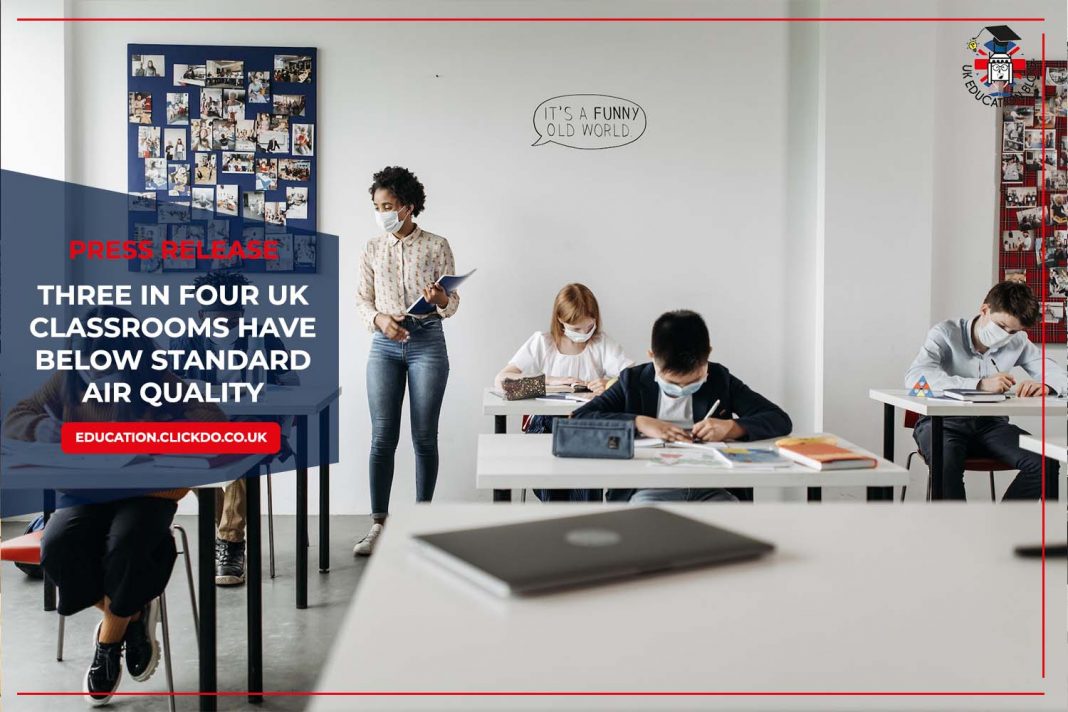90% of teachers agree that poor air quality impacts lung and mental health – and over half said it affects grades and academic performance.
Almost three in four (72%) classrooms suffer from air quality that is ‘below standard’, according to a new survey asking teachers across the UK about their school’s working conditions. Nearly three in five teachers (59%) deemed a classroom with poor air quality to be ‘not fit for purpose’ – for either teachers or pupils.
Three-quarters (77%) of teachers noticed that substandard air quality caused concentration problems in students, while 53% said performance or grades suffered.
The Air Quality in UK Classrooms Report – conducted by experts in air movement and ventilation solutions Airflow – asked teachers at 133 schools across the UK for their insights into working and learning conditions at UK schools.
The report found that conditions impacted student health, with three in five (61%) teachers believing classroom air quality is aggravating asthma and other lung conditions in pupils. Ill-effects on health were 55% more likely in cities, where both industrial and road pollution are more prevalent.
This comes in a summer where the UK saw record high temperatures, exacerbating pollution and its effects. Reports from scientists at the EU Copernicus Atmosphere Monitoring Service have warned of spikes in unhealthy levels of pollution around Europe*, which are likely to become more common each year. Increased pollution can irritate and inflame the lungs.
Read the full survey findings here:
https://www.airflow.com/about-us/blog/article?article_id=32&article_desc=The-Air-Quality-in-UK-Classrooms-Report
How are teachers being affected?
Almost two-thirds (63%) of all teachers surveyed said poor air quality is affecting teachers’ physical and mental health. While 31% of those at schools with ‘below standard’ air quality reported that despite requesting improvements, no action has been taken.
However, more than a quarter (27%) said their school is trying to improve air quality, but cannot due to a lack of funding or government support.
What improvements do teachers want to see?
Faced with sub-standard air quality, teachers identified the changes they want schools to make:
- Replace old heating appliances (which can contribute to indoor air pollution) – 72%
- Install air filtration or purification systems – 71%
- Ban cars on streets with schools during school run times – 38%
- Relocate playgrounds and classroom windows away from roads – 32%
With pupils currently on their summer holidays, now is the time for schools to make changes such as these.
Alan Siggins Managing Director of Airflow Developments Ltd said:
“We commissioned this survey to raise awareness of the problems poor air quality creates and how it impacts the classroom. Improving air quality is our area of expertise and we know the solutions available to overcome these problems.
“However, what we didn’t know and what this survey has highlighted is how bad the situation is and how it affects teachers and students. It’s clear that funding solutions need to be found quickly and there must be support from the upper reaches of government for that to happen. Investment in modern ventilation systems is a must for the health of the future generation: we’ve seen first-hand the stark difference good air quality can have.
“To gain this investment, grassroots pressure is required to focus the government and local councils on the issue. Schools, teachers, and even parents can raise the issue at PTA meetings or with local councilors to start turning the screw.
“The recent resurgence in Covid cases makes action on air quality even more pressing. Nobody wants a situation where children and teachers are returning to classrooms that facilitates the transmission of the virus. If measures are put into place, the health of both students and teachers can only benefit.”
Mrs. X, who works at a London primary school but did not want to be named for job security reasons, says:
“Returning to school after the pandemic, all schools were advised to keep windows open to improve air quality. However, in winter, the classrooms would obviously get very cold. Children would be distracted and this impacted learning.
“Even with windows open, pollution around the school area means that air quality is not drastically improved. We know that poor air quality and ventilation lead to higher levels of CO2 in the classroom, which affects cognitive performance (reduces memory, impairs concentration, lowers decision-making abilities) and inhibits learning.
“In addition, children who struggle with self-regulation find it particularly hard to be in poorly-ventilated environments and may demonstrate disruptive behaviour, leading to them being sent out of the classroom, meaning they are not learning from their teacher.
Nicola D’Urso, School Speech, and Language Therapist says:
“Some schools I work in have indoor areas which are poorly ventilated without any windows. I’ve seen examples of children fainting and disengaging due to dehydration in excessively hot and stuffy classrooms. It’s not uncommon for children to become drowsy and even the brightest students can stop interacting in lessons. I notice caring and responsible teachers often have to prioritize children’s health and wellbeing during lessons instead of teaching them the educational content.
“The main obstacle is that senior leadership teams in schools are at the mercy of their local council’s policy on clean air and limiting air pollution. The roadblock for schools is that it’s a bit out of their hands given that it’s up to the council and the government to get a grasp of air pollution and put adequate policies in place.”
— END —







